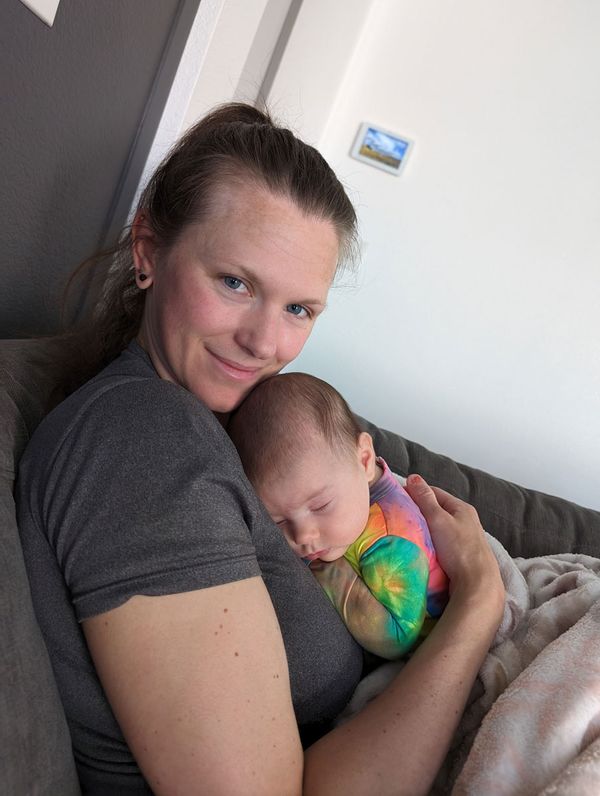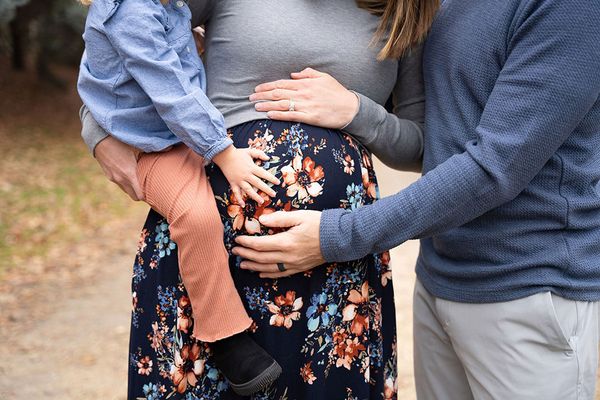Rebecca Vincen-Brown was still in her first trimester of pregnancy, in the late fall of 2022, when things started to go wrong. She had blood drawn for a standard genetic test called noninvasive prenatal testing, or NIPT, which can detect increased risks for various chromosomal disorders. The results of the test took slightly longer than normal to come back, and when they did, Vincen-Brown received a troubling phone call: The test was “inconclusive” because not enough fetal DNA was detected in her blood.
NIPT cannot diagnose fetal disorders conclusively, but the possibilities were troubling: Her fetus might have triploidy, trisomy 13 or trisomy 18, rare and serious genetic conditions involving either an extra set of chromosomes or an extra copy of one chromosome. While the specifics vary, most infants born with these conditions will live only days or weeks, and almost none will survive to adulthood.
When Vincen-Brown and her husband first learned she was pregnant with their second child a few weeks earlier, they were “over the moon,” she said. They’d been trying to conceive for nearly a year. She went to the attic of their house in Kuna, Idaho, a small town south of Boise, and began digging out some of the favorite baby clothes that her older daughter, then two years old, had outgrown. She even started to get the nursery set up for their new arrival. (Vincen-Brown has requested that Salon not identify her husband by name or occupation.)
After that confusing test result, the mood shifted dramatically. Vincen-Brown’s care team recommended a different test, called a nuchal translucency ultrasound, which yielded normal results. But she couldn’t shake the feeling of apprehension.
“They kept giving us a little bit of hope, saying, ‘There's still a chance, we don't know for sure what's going on, but we need to do further testing,’” Vincen-Brown, who is now 32, told Salon in an extended interview. “From there we held off on getting ready for the baby. I had hope, but at the same time, in your stomach, you kind of knew something wasn't right.”
A second NIPT once again yielded inconclusive results, indicating a high risk of the same three chromosomal abnormalities. After that, Vincen-Brown elected to have an early anatomy ultrasound scan at 16 weeks of pregnancy, rather than the usual 20 weeks. On March 6, 2023, she and her husband got the kind of news all prospective parents dread.
The ultrasound had detected “several fetal abnormalities,” in Vincen-Brown’s words. The fetus’ heart and kidneys had significant defects, and the network of blood vessels in the fetal brain had not properly attached to the ventricular wall. If the infant were even born alive, she said, “swallowing, eating or anything like that outside of the womb would have been impossible.” The overall result was a “long list of things that no modern medicine could make a life out of.”
As she would later learn, her fetus did indeed have triploidy, which appears to occur at random and is estimated to affect 1 to 3 percent of all pregnancies in the United States.
Vincen-Brown was offered two choices, both of them disheartening. “We could keep carrying the baby, which would likely lead to a miscarriage or a stillbirth, or the baby would be born full-term and shortly die after that,” she said. “Or we could get an abortion.”
 Rebecca Vincen-Brown and baby (Courtesy of Rebecca Vincen-Brown)But she couldn’t choose to do that in her hometown or anywhere else in Idaho, where the Republican Party is dominant and state legislators had passed one of the most restrictive abortion laws anywhere in the country.
Rebecca Vincen-Brown and baby (Courtesy of Rebecca Vincen-Brown)But she couldn’t choose to do that in her hometown or anywhere else in Idaho, where the Republican Party is dominant and state legislators had passed one of the most restrictive abortion laws anywhere in the country.
* * *
In June 2022, a few months before Vincen-Brown’s second pregnancy, the U.S. Supreme Court issued the now-famous decision in a case called Dobbs v. Jackson Women’s Health, which overturned the constitutional right to abortion care established nearly 50 years earlier by Roe v. Wade. After Dobbs, all states and U.S. territories could set their own laws about whether abortion would be legal and, if so, under what circumstances.
Even the exceptions in Idaho's abortion law had to be “proven by a preponderance of the evidence” showing that physicians had provided “the best opportunity for the unborn child to survive.”
Well before that, some anti-choice Republican officials had prepared for the possible overturn of Roe by passing “trigger laws,” meaning severe restrictions or outright abortion bans that would go into effect as soon as such a decision occurred. On March 24, 2020, Idaho Gov. Brad Little — a Republican, like every other statewide elected official — had signed S1385, which made it a crime to conduct all abortions except in cases of documented rape or incest, or in order to prevent the mother's death. Even those exceptions had to be “proven by a preponderance of the evidence” showing that physicians had provided “the best opportunity for the unborn child to survive” in their “good faith medical judgment.” Any doctor who violated the law could face up to five years in prison and lose their medical license.
Just before the Dobbs ruling, Idaho passed a second law that overlaps with the “trigger law” in confusing fashion. It prohibits all abortions after six weeks of gestation and allows for lawsuits against medical professionals who provide abortion services, or are suspected of doing so. It even encourages neighbors and community members to monitor pregnant people in their communities. Both laws were in effect by the time Vincen-Brown found out she was pregnant again.
After many sleepless nights and conversations with her doctors, Vincen-Brown and her husband decided they would travel to another state and terminate the pregnancy. The risks to her health, including possible miscarriage and hemorrhage, preeclampsia and the possibility of endangering future pregnancies, were just too high, they concluded.
“It was not a knee-jerk reaction, it was not a knee-jerk decision,” she said. “It was not a birth control decision. It was based on many tests.”
* * *
Vincen-Brown’s traumatic odyssey was nowhere near over, as it turned out. Largely because of what happened next, she would later become one of several plaintiffs in a case called Adkins v. Idaho, which seeks clarification of the limited exceptions to the state's abortion laws, as well as clearer language that physicians can apply in emergency situations. Among other things, the plaintiffs are demanding that Idaho’s exceptions to its near-total abortion ban be expanded to include fatal fetal anomalies, so that no pregnant person is forced to face the discouraging options that confronted Vincen-Brown.
Want more health and science stories in your inbox? Subscribe to Salon's weekly newsletter Lab Notes.
According to Marc Hearron, senior counsel for U.S. litigation at the Center for Reproductive Rights, which filed the lawsuit, Idaho’s two laws restricting abortion “have conflicting language with different standards” and fail to use standard “medical terminology.” Hearron and his team are asking for a change to the legal language of the laws that would allow physicians to provide abortion care when a pregnant person has “a medical condition or complication of pregnancy,” such as a risk of infection or bleeding, that poses a severe risk to herself, the fetus or both, or when “the fetus is unlikely to survive the pregnancy and sustain life after birth.”
Although the incidence of birth defects has steadily declined since the 1970s, an estimated 2 percent of pregnancies are diagnosed with a congenital anomaly each year in the U.S. But according to KFF, 13 of the 20 states that have restrictive abortion laws or early gestational limits in effect make no exceptions for fatal fetal anomalies.
This means that many women who find themselves in the already devastating situation of having a nonviable pregnancy must either be forced to stay home and carry a nonviable pregnancy to term or travel out of state to terminate. For those who do have the resources to travel — like Vincen-Brown, or Kate Cox, a woman from Dallas who made national headlines — things don’t necessarily get less difficult when they cross state lines.
* * *
After several rounds of phone calls to abortion providers in neighboring states, Vincen-Brown and her husband secured an appointment several days later at a clinic in Portland, Oregon, more than 400 miles away. Her husband took time off work and they loaded up the car. Since they had no reliable child care they brought along their two-year-old daughter, who was going through potty training at the time. They tried to make the journey seem like a “normal road trip,” Vincen-Brown said, offering their daughter “lots of bribery snacks” and occasionally stopping at a park or playground to let her play on the swings.
“We didn't want to be targeted, we didn't want to put our family at risk of any negative effects. We just didn't tell anybody what really happened, except for a few friends."
After seven hours on the road, they checked into their hotel in Portland. The next day, Vincen-Brown went to the clinic, where a physician dilated her cervix, the first stage of a normal abortion procedure. She went back to the hotel to rest, expecting to return the following day for the second part of the procedure, when the uterus is emptied.
But when Vincen-Brown tried to fall asleep that night, she started having painful cramps that kept getting worse, and became labor contractions by midnight. The on-call doctor at the abortion clinic told her that “cramping was normal,” she said. But she had experienced labor before, and understood what was happening.
“It just kept persisting, 30 seconds apart, 30 seconds apart, and the whole time I'm thinking to myself, I need to hold out until 8 a.m.,” when the clinic would open, she said. Around 3 o’clock in the morning, her contractions began to slow down, but the pain was exponentially worse, “the kind where you can't walk or stand up during them.” All this time, Vincen-Brown and her husband were trying not to wake their daughter, who was asleep across the room in a portable crib.
They called the clinic’s doctor one more time. He said he could come to their hotel room if necessary, but told Vincen-Brown to keep “hanging on.” She knew she needed urgent medical care, but their car was four blocks away in a valet parking lot. She didn’t want to call 911, since her out-of-state medical insurance wouldn’t cover the cost of an ambulance and an emergency-room visit.
 Rebecca Vincen-Brown (Courtesy of Rebecca Vincen-Brown)
Rebecca Vincen-Brown (Courtesy of Rebecca Vincen-Brown)
After that second phone call, Vincen-Brown had a miscarriage on the bathroom floor, at around 4 a.m. Her husband gave her a fundal massage in the shower, trying to control the potentially dangerous bleeding and painful cramping. The miscarried fetus lay on the bathroom floor for another four hours, until someone from the clinic finally arrived.
“We were just whispering, trying to be quiet, and my husband's taking phone calls in the hallway,” Vincen-Brown said. “Nothing about it was right. It was actually quite barbaric.”
The next day she went back to the clinic to finish the procedure, and then Vincen-Brown, her husband and their daughter — who had no idea what had just happened — drove another seven hours back to Idaho. Along with the shock, grief and physical and emotional trauma, she and her husband spent about $5,000 out of pocket for travel costs and the abortion procedure itself. She estimates she put 900 miles on her car.
We need your help to stay independent
Looking back on this nightmarish experience, Vincen-Brown draws what many would consider a logical conclusion: All of it could have been avoided if she had access to appropriate care in Idaho. “A lot of unnecessary complications happened that could have been foregone if we stayed home,” she said.
After Vincen-Brown and her husband first got home, they didn’t tell anybody they knew what happened. Their story was partly true: She’d had a miscarriage, and later testing determined that the fetus had a fatal anomaly.
Their semi-rural community on the southern edge of the Boise metro area, Vincen-Brown said, is “very loud” on the abortion issue. “We didn't want to be targeted, we didn't want to put our family at risk of any negative effects. We just didn't tell anybody what really happened, except for a few friends. We didn't want the judgment either.”
* * *
Jillaine St. Michel, 38, lives a few miles away from Vincen-Brown, in the same Idaho county, and became pregnant just a few months earlier. In July of 2022, she texted her husband that she had “very exciting” news. He knew what that meant: They, too, were having a second child and were elated about it. At first, everything went smoothly. At a first-trimester screening, St. Michel found out she was having another girl. At around 16 weeks of pregnancy, she announced the news on social media. When she went in for her 20-week anatomy scan, she told her husband she felt confident going alone.
St. Michel is a chiropractor who understands anatomy, and noticed during the sonogram, she said, that the fetus’ arms did not look quite right. The sonographer disappeared to talk to a specialist in the next room — and was gone for 20 minutes. Eventually, the doctor returned with a genetic counselor.
“My heart dropped,” she told Salon. “I knew something was not OK.” The doctor suggested that St. Michel call her husband, Brandon St. Michel, saying, “We've seen some really severe stuff that we want to go over with you.”
By the time her husband arrived 20 minutes later, St. Michel was in tears. The doctor told them the fetus had severe genetic and developmental conditions that impacted multiple organ systems. Because of a “caudal regression sequence,” the lower spine had not formed properly, nor had the bones of one leg. The fetus also had a cystic hygroma, a form of benign tumor that creates a high risk of miscarriage. Her pregnancy was unlikely to reach full term, the doctors said, and the infant would not survive past birth.
Doctors even asked St. Michel, she said, whether she had been exposed to toxic chemicals, because the complications of this pregnancy were so unusual.
St. Michel and her husband asked for help finding abortion services. The only thing the doctor could do was to hand them “a sheet of paper with a list of clinics in other states.”
She too confronted a range of options, none of them promising: St. Michel could seek additional imaging or consult a specialist. She could arrange “palliative care” for the fetus, aimed at reducing the suffering of a birth process that would likely also bring death. Some people in her situation, the doctor said, would choose to terminate the pregnancy.
St. Michel and her husband had never had that conversation, they said, but at that moment they both felt sure that the last option was right for their family.
They asked for help finding abortion services and the only thing the doctor could do was to hand St. Michel “a sheet of paper with a list of clinics in other states.” The doctor told her, “I don't even know how updated this is, the laws are changing so rapidly in other places. This is the best we can do here, because it’s illegal in our state.”
* * *
Dr. Julie Lyons, a family physician who is chief of staff of St. Luke’s Wood River Medical Center in Hailey, Idaho, is another plaintiff in the case against the state. She’s familiar with those sheets of paper. It feels like physicians “are being gagged” and their “hands are being tied” when it comes to helping the patients get the resources they need, she said.
The summer of 2023 was “especially horrific” in Idaho, Lyons said. State Attorney General Raúl Labrador — a far-right Republican and staunch supporter of Donald Trump — wrote a letter suggesting that sending a patient out of state for treatment could be considered “aiding and abetting” and could put a doctor’s medical license at risk. That sent “shock waves” through Idaho’s medical community, she said. (Salon repeatedly contacted Labrador’s office and received no response).
“I have had several patients who have had to leave the state since the abortion laws have been passed, for fatal fetal diagnoses,” Lyons said. She recalled one patient who spent three hours making phone calls to clinics, and ultimately spent more than $1,000 on airfare and travel.
“It is a very big, traumatic grieving process for the patient, as well as the physician delivering the news,” Lyons said, and Idaho’s laws have introduced unnecessary extra steps, in terms of “advocacy to ensure that our patient gets the health care they need and deserve.” Idaho’s laws, she suggested, make women who face these painful situations feel stigmatized: “It takes away the ability to grieve publicly.”
Working from their sheet of paper, St. Michel and her husband found several non-working phone numbers for clinics that had shut down. Among those still open, most had lengthy waiting lists.
After two days of increasingly frantic calls, they connected with a clinic in Seattle that had an unexpected opening. They scrambled to buy three last-minute plane tickets and three nights in a hotel. Like Vincen-Brown, they had no choice but to bring their older daughter along.
 Jillaine St. Michel and family (Courtesy of Jillaine St. Michel)
Jillaine St. Michel and family (Courtesy of Jillaine St. Michel)
At the Seattle clinic, St. Michel went to her appointment for dilation and evacuation, or D&E, alone. “I had to say goodbye to this extremely wanted child by myself,” she said. “That was taken away from my husband, which should have never happened.”
Within a few weeks, the sadness had given way to anger. “I started to get really, really angry about how things went down,” she said. “The more I thought about it, and after my grief settled a bit, I realized that was not OK.”
* * *
It’s reasonable to wonder about the alternative case: What is likely to happen when a pregnant woman carries a nonviable pregnancy to term? In terms of physical risk to the mother, there is no single straightforward answer: It depends on the circumstances, medical experts told Salon, especially the nature of the fetal anomalies, the mother’s previous health history and her previous pregnancies, if any. That makes it difficult for providers in states like Idaho to terminate a pregnancy under the “life of the mother” exception often written into abortion laws.
“I had to say goodbye to this extremely wanted child by myself. That was taken away from my husband, which should have never happened.”
Providing obstetrical care to a pregnant patient carrying a fetus with severe fetal anomalies is “very nuanced,” Lyons said. “Each patient does have their own individual risk. We can't always assess when or how, and that's what's so frustrating about these laws: They don't allow doctors the autonomy that we need to provide nuanced care.”
Dr. Maria Phillis, a maternal fetal medicine specialist, told Salon that continuing with a pregnancy under such circumstances is nearly always riskier than termination.
To some extent, she said, it’s a simple equation: “If you think about benefit versus risk, pregnancy is always more dangerous than not being pregnant.” Indeed, in a 2012 researchers study published in the journal Obstetrics & Gynecology, researchers concluded that the risk of dying in childbirth was “approximately 14 times higher than that with abortion.”
Many people confronted with likely fatal fetal anomalies would conclude, Phillis said, that “the risks that I would be willing to undergo to my own health and life to obtain a healthy pregnancy are not worthwhile in this situation.” But there’s no right or wrong answer, she said, in either moral or medical terms: “Every patient is a different person, and they have different thoughts about what they want to do. The key is to provide options.”
* * *
Caitlin Silverstein is very familiar with women who face the trauma of “no good choice.” She’s a licensed social worker and therapist in New York who specializes in perinatal loss, including stillbirths, miscarriages and terminations performed for medical reasons. Much of her work, when supporting pregnant women going through the decision to terminate a nonviable pregnancy, is to validate that trauma, she says.
For the patient, that process involves “multilayered grief,” Silverstein said, which begins with hearing a dire diagnosis. Follow-up tests may offer some hope, but when the outcomes are unfavorable that can lead to deeper feelings of loss and grief. When a woman chooses to terminate the pregnancy, Silverstein tries to help her manage the depression, anxiety and shame that can come along with that decision. The current landscape of ever tighter legal restrictions on abortion care, she believes, only makes the emotional and psychological effects worse.
A pregnant person may be thinking that “the government doesn't think that this is good for me to do, I shouldn't be doing this — but I don't want this future for my child,” she said. No parent wants a child to lead a life of pain and suffering, and through that lens many may conclude that termination is the most compassionate option. Women who feel that choice being taken away, Silverstein said, are at risk of “hopelessness,” a principal component of depression. “You're going to feel trapped, you’re going to feel hopeless, isolated, stigmatized, already more than you already would be,” she said. “Regardless of what choices they had to make for whatever reason,” women facing this situation “have lost a child. They are grieving mothers."
For Jillaine St. Michel, being open about what happened led to the realization that she was not alone, and that many other women have faced similar situations.
“Regardless of what choices they had to make for whatever reason,” women facing this situation “have lost a child. They are grieving mothers."
“I had people from work that I'm not even that close with, that I would have never expected would even approach me, tell me how proud they are of me,” she said. Several told her they had daughters of their own and were glad “that somebody is speaking up.”
That made her wonder where restrictive abortion laws like Idaho’s were coming from, and why legislators in her state and many others were passing them.
“Who is part of this? It's a very small minority of people,” St. Michel said. “So why is this happening? It's very, very confusing.”
A report published in January 2024 by Boise State University’s Idaho Policy Institute found that only 33 percent of those surveyed in Idaho — by any standard, one of the most conservative states in the country — supported keeping the current abortion laws intact, while 58 percent supported changing them. Within that second cohort, 24 percent wanted to expand the law’s exceptions to allow termination in the case of a nonviable pregnancy, while the other 34 percent favored either no restrictions at all or unrestricted access until 22 or 24 weeks of pregnancy. Nationwide, according to Pew Research Center, 63 percent of Americans say abortion should be legal in all or most cases.
* * *
In January 2023, the Idaho Supreme Court took up a case arguing that the state’s abortion laws violated the state constitution, which contains language about fundamental privacy rights and the right to make family decisions. But the justices upheld Idaho’s abortion ban by a 3-2 vote, writing in the majority opinion that they “cannot read a fundamental right to abortion into the text of the Idaho Constitution.”
The current case, Adkins v. Idaho, rests on a similar argument that the laws violate the state constitution, but Hearron says his legal team is demanding the “bare minimum” in asking the state to expand and clarify exceptions to current law. “The risk of death does not have to be imminent or extremely high in order for that right to access abortion care to exist,” he said. “We're not asking here for all of the abortion bans to be stricken down in their entirety.”
 Jillaine St. Michel (Courtesy of Jillaine St. Michel)
Jillaine St. Michel (Courtesy of Jillaine St. Michel)
More recently, the Texas Supreme Court rejected a challenge to that state’s restrictive abortion laws. Plaintiffs in that case were women who’d had serious pregnancy complications. One of them, Amanda Zurawski, spent days in intensive care with sepsis after being denied an abortion when her water broke at 18 weeks. Similar lawsuits have been filed in Tennessee and North Dakota.
Personal stories, like those of Vincen-Brown and St. Michel, will serve to illustrate the “harm” done to Idaho citizens, Hearron said. “We’re going to ask the court to alleviate that harm and vindicate constitutional rights.” A trial is scheduled for November.
Meanwhile, pregnant women in Idaho, as in many other states, continue to struggle with the consequences of these laws.
Vincen-Brown and St. Michel both got pregnant for a third time after their traumatic terminations. There’s good news: Both women delivered healthy babies in the end. But their journeys to that destination were clouded with fear and anxiety, they say.
“We couldn't go through this feeling blissful,” St. Michel said. “It was always like: What if?”
Vincen-Brown said that this time around she never stepped into the nursery until after she had a full anatomy scan. She kept the door to that room closed.
“We didn’t tell people about it. We didn't get excited and jovial, like you would when you’re pregnant, because of the fear of it happening again.” Her entire third pregnancy, she said, had been “tainted.”
Read more
about abortion in the Dobbs era



Shares